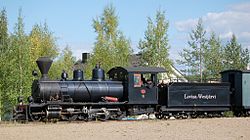
The vast majority of Finnish narrow-gauge railways were owned and operated by private companies. There are only a few instances where narrow-gauge railways were in direct connection with each other, and those interchanges did not last for long. The railways never formed a regional rail traffic network, but were only focused on maintaining connections between the national Russian-gauge railway network and the off-line industries.
Contents
Some railways were closed due to competition from the roads, others were converted to 1,524 mm (5 ft) Russian gauge.